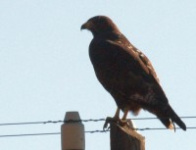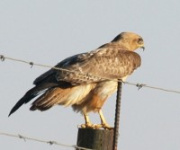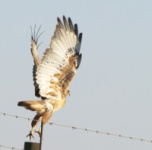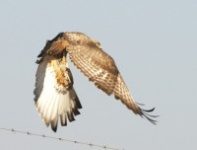



On the 3rd of July 2010 we travelled back from Durban to Johannesburg and decided to make the most of the trip so out came the journal and the hunt was on to see how many birds we could see on the trip. We pulled over a number of times along the way to take a closer look at raptors sitting on telephone poles and spent time checking out dams along the way. We took the alternate route via Winterton and the Sterkfontein Dam and then did the Harrismith & Witsieshoek route as described in chapter 98 of Birding Gauteng. Although we did not complete the Witsieshoek part this time.
Most of the raptors we saw on the route turned out to be Jackal Buzzard and some were juveniles (although a Booted Eagle flew past as we were driving and escaped without leaving any proof! And a Rock Kestrel gave us a tantalising view before flying off into the distance never to be seen again! Another potential Lifer gets away!!!):
One of our surprises came near the Sterkfontein Dam - just past the entrance to the resort - where in a field with a small dam we first spotted two Blue Crane and then noticed two other large birds...Grey Crowned Crane - without a doubt it was the highlight of our trip! And just as well, because we did not see a single Crane on the whole Eeram Cranes circuit to the north of Harrismith. Rather disappointing to put it mildly!!! And we even went to the dam 300 metres from an arb little crossroad in the middle of nowhere as instructed and saw one Cormorant and not "large concentration of Cranes" as promised. Is there a money back guarantee for "Birding Gauteng"? I'll check the preface again!
In this same little dam there were two Shelduck - a male and a female (not a Lifer for me, but a slightly better pic than I have gotten before):
Another surprise came when I checked my photos on our return and realised that what I thought were Spur-winged Goose flying overhead near Winterton were in fact Grey Crowned Crane - seems like the species is doing well as there must have been around 30 birds in the different flocks that we saw in the distance:
An incredibly bird rich area proved to be some farmland just outside the town of Winterton - we stopped for our first ever sighting of White-backed Raven and soon were enjoying sights of Cattle Egret, Black-headed Heron, White Stork, Hadeda Ibis and Southern Bald Ibis:
Up to this point on our trip we had recorded: African Stone Chat, Cape Longclaw, Sacred Ibis, Pied Crow, Jackal Buzzard, House Sparrow, Cape Crow, Cattle Egret, Black-shouldered Kite, Little Grebe, Red-knobbed Coot, African Black Duck, Quelea, Black-headed Heron, Common Fiscal, Southern Red Bishop, Blacksmith Lapwing, Pied Starling, Cape Glossy Starling, Hadeda Ibis, Fork-tailed Drongo, White Stork, White-backed Raven, Grey Heron, Rock Pigeon, Red-winged Starling, Grey Crowned Crane, Blue Crane, South African Shelduck, Common Ostrich - and we were only half way home and were about to do the Harrismith route. Unfortunately our great expectations were not matched - maybe it should have been done early morning - but all we saw were Red-capped Lark, Red-collared Widowbird, Helmeted Guineafowl and a lonely looking White-breasted Cormorant at the dame where the Cranes were supposed to be lined up for a great photograph shoot (maybe their had been urged to go into their trailer by their union leaders).
We even travelled the Botha's Lark Triangle road - although I was not so much looking for the two Lark specials given the time of year. The only Larks we saw in the area were Spike-heeled Lark and Red-capped Lark.
And the scenery around the 2 windmills mentioned in Birding Gauteng was a special treat as well (even without the presence of a Botha's Lark):
Just before we headed back to the main road we got a tantalising view of a raptor that flew off when I got to within 40 metres of it. This is as good as my pics get unfortunately. It is possibly Greater Kestrel:
To be honest, what we did see in the Harrismith area made every minute on the rough dirt roads worth our while - a much better way of doing the 6 hours from Durban to Joburg is to get off the long and boring tar road and do some quality birding! Even the sight of a male and female African Stonechat, though so common, can be a treat!
Witsieshoek - December 2010
In December 2010 on or way back from St Lucia we visited Witsieshoek - a site mentioned in chapter 96 of Birding Gauteng. The drive up to the quaint mountain resort passed awesome sandstone formations. Here are some scenery pics of our trip:
I was hoping to see Drakensberg Siskin but in my ignorance got excited taking photos of what turned out to be Cape Canary - I needed better shots of this bird, but I was rather disappointed to not see the Siskin:
Here are some other shots that I got - the Lesser Kestrel, a lifer for me, was taken on the road to Harrismith:
On the road back to Harrismith we saw this male and female Lesser Kestrel, a lifer for me:
A bird that I am still waiting to confirm - is this Pipit taken at the resort. It just might be Mountain Pipit:
Botha's Lark Triangle - December 2010
On a trip from Durban via Witsieshoek to Joburg in December 2010 we visited the Botha's Lark Triangle (chapter 98 in Birding Gauteng) to have another shot at finding Botha's Lark - but apart from one intriguing pic it seems like we were unlucky (and this just might be a female Southern Red Bishop):
Here are some scenery pics and pics of birds we saw in the area:
On a trip back from Lesotho on the 4th of January 2011, we visited the spot once again. And even though I heard Botha's Lark, apart from African Pipit, Spike-heeled Lark and Cape Longclaw once again we came away empty handed. When we passed the farm on the way to the windmills we had to park and proceed on foot as the road was totally flooded. The water level was above our knees. Here are some pics of the birds we saw:
Alexpan Trip - February 2011
On Saturday morning the 19th February 2011, I left home at 2am to meet up with a fellow birder (SafariRanger) in Benoni and we set off for Alexpan near Harrismith. We were chasing the rare sighting of the Red Phalarope that had been spotted at the pan during the week.
We did some birding in the area on the way to the day where we heard and saw and photographed Blue Korhaan (a lifer for me); we walked among lots of Common Quail (but did not get a single sighting); finally arriving at the pan where we saw ... no Red Phalarope nor Black-necked Grebe - despite scanning with binocs and a huge scope!
On or around the pan we saw Southern Bald Ibis, Spotted Thick-knee, Little Grebe, Great Crested Grebe, Cormorants, South African Shelduck, Red-knobbed Coot, Yellow-billed Duck, Blacksmith Lapwing,Red-billed Teal, Grey Heron, Black-headed Heron, Maccoa Duck, Whiskered Tern, Amur Falcon and Swainson's Spurfowl.
Suddenly SafariRanger spotted a Black-necked Grebe on the far side of the pan and at least I knew I would be in for a lifer on the pan even if the Phalarope did not appear - but it was way too far off to photograph, I could not even see it with the naked eye! Not a good start to our time at Alexpan!
We had driven a long way from Joburg and were feeling a little disappointed but strangely I was optimistic. As we walked towards the hay bales closer to the pan we were joined by another birder (Bruce Ward-Smith) who had just arrived. We soon understood why the rarity report suggested wellies were necessary - it was very wet and muddy around the pan. We decided to make our way right around the pan and as we set off Bruce spotted the Red Phalarope - it was much smaller than I was anticipating, about the size of a Marsh Sandpiper. It was way off towards the middle of the pan and it was not looking promising for photos. Bruce and I decided to get a little closer to the bird and waded in up to our knees on the western side of the pan - and were rewarded with these shots (sadly the rising sun was behind the bird) (in the first shot I have circled the Phalarope to show it's diminutive size):
We then headed around to the other side of the pan to try our luck from that side and got a few more shots, but the bird kept disappearing and was really hard to find again - it would get lost among all the grass stalks growing through the water surface. Here is a shot that I got from the southern side of the pan:
Pretty lame shots, I know, but you must know how much effort went into getting them! Hopefully SR and Bruce will post some shots they got with their better camera's and lenses.
Here is a scenery shot of western side of the pan:
While we were there and back on the Southern side of the pan I managed to get a few shots of the Black-necked Grebe (I have looked for this bird for over a year!):
The other highlight of the outing was a few shots of the Blue Korhaan - another bird that I have been hunting for over a year (sadly this flying pic is the best I managed in the poor light at the crack of dawn):
Some other highlights of the day included Blue Crane (with a juvenile bird - you can see it behind the two adult birds in the pic), Rock Kestrel, Jackal Buzzard, African Quailfinch, Cisticolas (Wing-snapping, Cloud, Zitting and Levaillants), Spotted Thick-knee (more than 12 in one field), Banded Martin and Grey-winged Francolin. Here are a few shots:
All in all it was a superb day out!